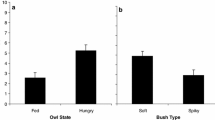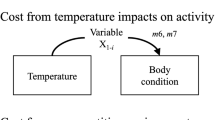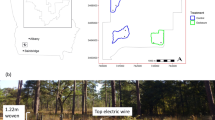Abstract
In an experiment on territorial brown trout (Salmo trutta), we addressed the novel hypothesis that protective cover increases the value of a territory in relation to the perceived level of predation risk. We predicted that territory holders should invest more resources defending territories with cover than territories without cover, and that defence should increase as predation risk increases. First, trout were allowed to establish ownership in territories with or without overhead cover. Second, predation risk was manipulated by simulating aerial predator attacks in half of the territories of each type, whereupon the preference for cover was estimated. Third, owners of the four types of territories were staged in dyadic contests against size-matched intruders. Territory owners showed a preference for cover, which increased further after simulated predator attacks. In subsequent contests, conflicts over territories with cover were settled faster than conflicts over territories without cover, which may suggest that the value of cover increases the motivational asymmetry between owner and intruder. Consistent with our hypothesis, owners of territories with cover were much more aggressive if they had been subjected to predator attacks the day before the conflict. These results suggest that territory owners are able to estimate the value of protective cover in response to variation in the level of predation risk in the habitat.



Similar content being viewed by others
References
Armstrong JD, Herbert NA (1997) Homing movements of displaced stream-dwelling brown trout. J Fish Biol 50:445–449
Beck CW, Watts BD (1997) The effect of cover and food on space use by wintering song sparrows and field sparrows. Can J Zool 75:1636–1641
Beletsky LD, Orians GH (1989) Territoriality among male red-winged blackbirds. III. Testing hypotheses of territorial dominance. Behav Ecol Sociobiol 24:333–339
Bohlin T, Sundström LF, Johnsson JI, Höjesjö J, Pettersson J (2002) Density-dependent growth in brown trout: effects of introducing wild and hatchery fish. J Anim Ecol 71:683–692
Boss SM, Richardson JS (2002) Effects of food and cover on the growth, survival, and movement of cutthroat trout (Oncorhynchus clarki) in coastal streams. Can J Fish Aquat Sci 59:1044–1053
Bradbury JW, Vehrencamp SL (1998) Principles of animal communication. Sinauer, Sunderland, Mass.
Davies NB, Houston AI (1981) Owners and satellites: The economics of territory defence in the pied wagtail, Motacilla alba. J Anim Ecol 52:621–634
Diaz-Uriarte R (1999) Anti-predator behaviour changes following an aggressive encounter in the lizard Tropidurus hispidus. Proc R Soc Lond B 266:2457–2464
Diehl S (1992) Fish predation and benthic community structure: the role of omnivory and habitat complexity. Ecology 73:1646–1661
Dukas R, Kamil AC (2000) The cost of limited attention in blue jays. Behav Ecol 11:502–506
Eason P, Hannon SJ (1994) New birds on the block: New neighbors increase defensive costs for territorial male willow ptarmigan. Behav Ecol Sociobiol 34:419–426
Elliott JM (1994) Quantitative ecology and the brown trout. Oxford University Press, Oxford
Endler JA (1995) Multiple-trait coevolution and environmental gradients in guppies. Trends Evol Ecol 10:22–29
Enquist M, Leimar O (1987) Evolution of fighting behaviour: the effect of variation in resource value. J Theor Biol 127:187–205
Enquist M, Leimar O, Ljungberg T, Mallner Y, Segerdahl N (1990) A test of sequential assessment game: fighting in the cichlid fish Nannacara anomala. Anim Behav 40:1–14
Fausch KD (1984) Profitable stream positions for salmonids: relating specific growth rate to net energy gain. Can J Zool 62:441–451
Fenderson OC, Everhart H, Muth KM (1968) Comparative agonistic and feeding behavior of hatchery-reared and wild salmon in aquaria. J Fish Res Bd Can 25:1–14
Hack MA (1997) Assessment strategies in the contests of male crickets, Acheta domesticus (L.). Anim Behav 53:733–747
Hilton GM, Ruxton GD, Cresswell W (1999) Choice of foraging area with respect to predation risk in redshanks: the effects of weather and predator activity. Oikos 87:295–302
Huntingford FA, Turner AK (1987) Animal conflict. Chapman and Hall, London
Jenkins TM (1969) Social structure position choice and microdistribution of two trout species (Salmo trutta and Salmo gairdneri) resident in mountain streams. Anim Behav Monogr 2:57–123
Johnsson JI, Åkerman A (1998) Watch and learn: preview of the fighting ability of opponents alters contest behaviour in rainbow trout. Anim. Behav. 56:771–776
Johnsson JI, Forser A (2002) Residence duration influences the outcome of territorial conflicts in brown trout (Salmo trutta). Behav Ecol Sociobiol 51:282–286
Johnsson JI, Nöbbelin F, Bohlin T (1999) Territorial competition among wild brown trout fry: effects of ownership and body size. J Fish Biol 54:469–472
Johnsson JI, Carlsson M, Sundström LF (2000) Habitat preference increases territorial defence in brown trout (Salmo trutta). Behav Ecol Sociobiol 48:373–377
Johnsson JI, Sernland E, Blixt M (2001) Sex-specific aggression and anti-predator behaviour in young brown trout. Ethology 107:587–599
Kalleberg H (1958) Observations in a stream tank of territoriality and competition in juvenile salmon and trout (Salmo salar L. and S. trutta L.). Rep Inst Freshw Res Drottningholm 39:55–98
Krause J, Godin J-GJ (1996) Influence of prey foraging posture on flight behavior and predation risk: predators take advantage of unwary prey. Behav Ecol 7:264–271
Krebs J (1982) Territorial defence in the great tit (Parus major): Do residents always win? Behav Ecol Sociobiol 11:185–194
Leimar O, Enquist M (1984) Effects of asymmetries in owner-intruder conflicts. J Theor Biol 111:475–491
Lima SL, Dill LM (1990) Behavioral decisions under the risk of predation: a review and prospectus. Can J Zool 68:619–640
Maynard Smith J (1979) Game theory and the evolution of behaviour. Proc R Soc Lond B 205:475–488
Maynard Smith J, Parker GA (1976) The logic of asymmetric contests. Anim Behav 24:159–175
Nijman V, Heuts BA (2000) Effect of environmental enrichment upon resource holding power in fish in prior residence situations. Behav Process 49:77–83
Reinhardt UG, Healey MC (1997) Size-dependent foraging behaviour and use of cover in juvenile coho salmon under predation risk. Can J Zool 75:1642–1651
Riechert SE (1998) Game theory and animal contests. In: Dugatkin LA, Reeve HK (eds) Game theory and animal behaviour. Oxford University Press, New York, pp 64–93
Sneddon LU, Taylor AC, Huntingford FA (1999) Metabolic consequences of agonistic behaviour: crab fights in declining oxygen tensions. Anim Behav 57:353–363
Stoks R (1999) Autotomy shapes the trade-off between seeking cover and foraging in larval damselflies. Behav Ecol Sociobiol 47:70–75
Tabor RA, Wurtsbaugh WA (1991) Predation risk and the importance of cover for juvenile rainbow trout in lentic system. Trans Am Fish Soc 120:728–738
Tobias J (1997) Asymmetric territorial contests in the European robin: the role of settlement costs. Anim Behav 54:9–21
Walther BA, Gosler AG (2001) The effects of food availability and distance to protective cover on the winter foraging behaviour of tits (Aves: Parus). Oecologia 129:312–320
Vásquez RA, Ebensperger LA, Bozinovic F (2002) The influence of habitat on travel speed, intermittent locomotion, and vigilance in a diurnal rodent. Behav Ecol:182–187
Acknowledgements
J.I.J. was financed by the Swedish Research Council for Environment, Agricultural sciences and Spatial Planning. We thank Ragnar Lagergren for helpful comments on the manuscript. The experiments were approved by the Ethical Committee for Animal Research in Göteborg (license 47/99), and comply with current laws in Sweden.
Author information
Authors and Affiliations
Corresponding author
Additional information
Communicated by J. Krause
Rights and permissions
About this article
Cite this article
Johnsson, J.I., Rydeborg, A. & Sundström, L.F. Predation risk and the territory value of cover: an experimental study. Behav Ecol Sociobiol 56, 388–392 (2004). https://doi.org/10.1007/s00265-004-0791-8
Received:
Revised:
Accepted:
Published:
Issue Date:
DOI: https://doi.org/10.1007/s00265-004-0791-8




